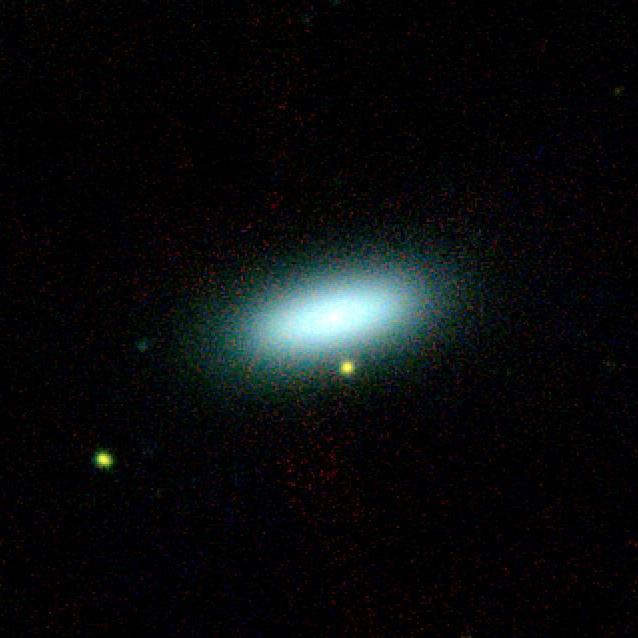LEDA 74886 on:
[Wikipedia]
[Google]
[Amazon]
LEDA 74886, also known by its

2MASX
The Two Micron All-Sky Survey, or 2MASS, was an astronomical survey of the whole sky in infrared light. It took place between 1997 and 2001, in two different locations: at the U.S. Fred Lawrence Whipple Observatory on Mount Hopkins, Arizona, and ...
designation 2MASX J03404323-1838431, and sometimes known as the Emerald-cut Galaxy, is a dwarf galaxy
A dwarf galaxy is a small galaxy composed of about 1000 up to several billion stars, as compared to the Milky Way's 200–400 billion stars. The Large Magellanic Cloud, which closely orbits the Milky Way and contains over 30 billion stars, is so ...
with a rare rectangular shape. It is located at a distance of about in the Eridanus constellation
A constellation is an area on the celestial sphere in which a group of visible stars forms Asterism (astronomy), a perceived pattern or outline, typically representing an animal, mythological subject, or inanimate object.
The first constellati ...
. The galaxy was detected in a wide field of view
The field of view (FOV) is the angle, angular extent of the observable world that is visual perception, seen at any given moment. In the case of optical instruments or sensors, it is a solid angle through which a detector is sensitive to elec ...
image taken by the Subaru Telescope
is the telescope of the National Astronomical Observatory of Japan, located at the Mauna Kea Observatory on Hawaii. It is named after the open star cluster known in English as the Pleiades. It had the largest monolithic primary mirror in the ...
using the Subaru Prime Focus Camera (Suprime-Cam). Using the Keck Telescope
The W. M. Keck Observatory is an astronomical observatory with two telescopes at an elevation of 4,145 meters (13,600 ft) near the summit of Mauna Kea in the U.S. state of Hawaii. Both telescopes have aperture primary mirrors, and, when c ...
, a thin disc
Disc or disk may refer to:
* Disk (mathematics), a two dimensional shape, the interior of a circle
* Disk storage
* Optical disc
* Floppy disk
Music
* Disc (band), an American experimental music band
* ''Disk'' (album), a 1995 EP by Moby
Other ...
with a side on orientation was confirmed to be lurking at the center of LEDA 74886, and spinning at a speed of 33 km/s at the orbital radius of half a kpc. LEDA 74886 has a mass of around 109 M☉ (Compared to the Milky Way
The Milky Way or Milky Way Galaxy is the galaxy that includes the Solar System, with the name describing the #Appearance, galaxy's appearance from Earth: a hazy band of light seen in the night sky formed from stars in other arms of the galax ...
's mass of about 1012 M☉).
Location
LEDA 74886 is located in thecelestial sphere
In astronomy and navigation, the celestial sphere is an abstract sphere that has an arbitrarily large radius and is concentric to Earth. All objects in the sky can be conceived as being projected upon the inner surface of the celestial sphere, ...
at a right ascension
Right ascension (abbreviated RA; symbol ) is the angular distance of a particular point measured eastward along the celestial equator from the Sun at the equinox (celestial coordinates), March equinox to the (hour circle of the) point in questio ...
() of , and a declination
In astronomy, declination (abbreviated dec; symbol ''δ'') is one of the two angles that locate a point on the celestial sphere in the equatorial coordinate system, the other being hour angle. The declination angle is measured north (positive) or ...
() of (J2000
In astronomy, an epoch or reference epoch is a moment in time used as a reference point for some time-varying astronomical quantity. It is useful for the celestial coordinates or orbital elements of a celestial body, as they are subject to ...
). It is located within the Galactic corona
The terms galactic corona and gaseous corona have been used in the first decade of the 21st century to describe a hot, ionised, gaseous component in the galactic halo of the Milky Way. A similar body of very hot and tenuous gas in the halo ...
of NGC 1407, a massive spherical galaxy which is located approximately 163,000 ly (50 kpc) to the northwest of LEDA 74886.
See also
* SDSS J074018.17+282756.3 is a spiral galaxy with arms that have a somewhat squarish-looking interior, but is distinct from LEDA 74886, because LEDA 74886 has no apparent spiral structure and a boxy like exterior form. *Sextans A
Sextans A (also known as UGCA 205) is a small dwarf irregular galaxy. It spans about 8000 light-years across, and is located at 4.3 million light-years away, in the outskirts of the Local Group of galaxies, which includes the Milky Way galaxy, a ...
, a member of the local group
The Local Group is the galaxy group that includes the Milky Way, where Earth is located. It has a total diameter of roughly , and a total mass of the order of .
It consists of two collections of galaxies in a " dumbbell" shape; the Milky Way ...
, has a box like form due to its expanding shell of young blue stars, but it has a much lower mass and density, and includes a central disc which LEDA 74886 does not include.
* NGC 4488

References
{{DEFAULTSORT:LEDA 74886 Eridanus (constellation) Lenticular galaxies 074886